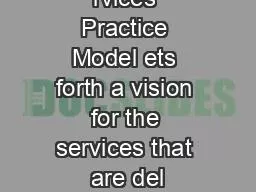

We believe that children do beChildren are best served when we provide their families with the supports necessary to raise them safely Services to preserve the family unit and centered and communi ID: 899726
Download Pdf The PPT/PDF document "rvices Practice Model ets forth a vision..." is the property of its rightful owner. Permission is granted to download and print the materials on this web site for personal, non-commercial use only, and to display it on your personal computer provided you do not modify the materials and that you retain all copyright notices contained in the materials. By downloading content from our website, you accept the terms of this agreement.
1 rvices Practice Model ets forth a vision
rvices Practice Model ets forth a vision for the services that are delivered especially the Departments of Social Services, Developmental Services and the Office of Comprehensive Services. The practice model is central to our decision making; present in all of our meetings; and in every interaction that we have with a child or family. Deciprocess to continuously improve services for children most accurate and current data available, and with the safety and well-being of children and families as the fixed center of our work. We believe that all children and communities deserve to be safe.Safety comes first. Every child has the right to livsafe community. Ensuring safety requires a collaborative effort among family, agency staff, and the community. We value family strengths, perspectives, goals, and plans as central to creating and maintaining child safety, and recognize that removal from home is not the only way to ensure child or community In our response to safety and risk concerns, we reach factually supported conclusions in a timely and mily, and community stakeholders is a necessary component in assuring safety. fety from children in need of protection. When court action is necessary to make a child safe, we use our authority with respect and sensitivity. We believe in family, child, and youth-driven practice. ll-being as well as in service and educational ill be respected within the limits of established community standards and laws. Children have a right to connections with their biologthey have developed emotional ties. implement creative, individual solutions that build on their strengths to meet their needs. We believe
2 that children do beChildren are best ser
that children do beChildren are best served when we provide their families with the supports necessary to raise them safely. Services to preserve the family unit and centered, and community-based. People can and do make positive changes. The paWhen children cannot live safely with their families, kinship connections capable of providing a safe and nurturing home. We value the resources within extended family networks and are committed to seeking them out. When placement outside the extended family is necessary, we encourage healthy social development by supporting placements that promote family, sibling and community connections. mily that is committed to the child. Placements in non-family settings should be temporary, should focus on individual childrens needs, and should prepare them for return to family and community life. We believe that all children and youtpreserve kinship, sibling and community connections for each child. We value past, present, and onship such as parental custody, adoption, kinship care or guardianship. Placement stability is not permanency. achieving permanency with another family. t contact with the childrens services system. We to ensure that family connections are stable. ild and family success in a system that is family- focused, child-centered, and community-based. We are committed to aligning our system with what is best for children, youth, and families. Our organizations, consistent with this , are focused on providing supports to families should guide all of the work that we do. In addition to st be aligned with the model. For example, untability, and transparency at all levels of our system and acro
3 ss all agencies. We share success stori
ss all agencies. We share success stories and best practices to promote challenges and lessons learned to make better Community support is crucial for families in raising children. We are committed to working across agencies, stakeholder groups, and communities to improve children and families achieve success in life; safety; life in the community; family based placements; and life-long family connections. communication must reinforce the belief that children and youth belong in family and community settings and that system resources must be allocated in a manner consistent with that belief. We are committed to working collaboratively to ensure that children with disabilities receive the supports necessary to enable them to receive their special education services within the public schools. ilities who are struggling in public school settings for private school placements, recognizing that the provision of such services will maxiand within their communities. We believe that how we do our work skillful professionals to engage and assist them. As with families, we look for strengths in our organization. We are responsible for creating and maintaining a supportive working and learning environment and for open, respectful ty, timely, efficient, and effective services. ildren, families, and community providers are conducted with genuineness, empathy, and respect. information is a non-negotiable part of how we effectiveness and guide policy decisions. We must strive to align our laws so that collaboration and sharing of data can be achieved to better support our children and families As we work with children, families, and their teams